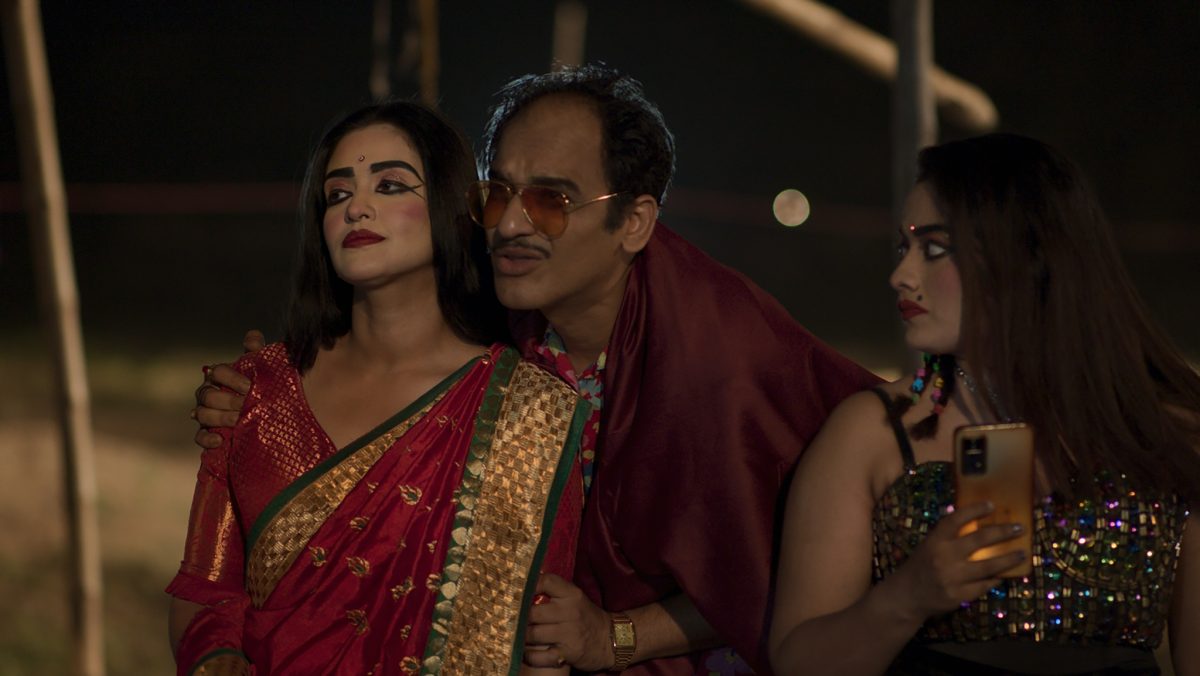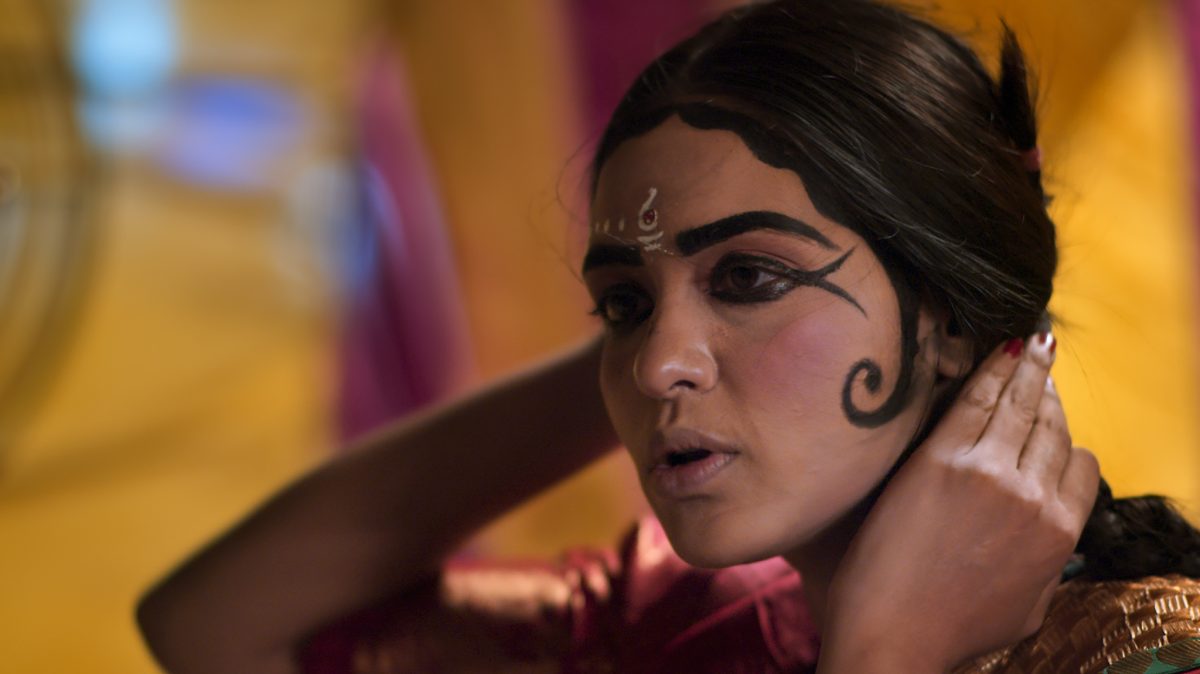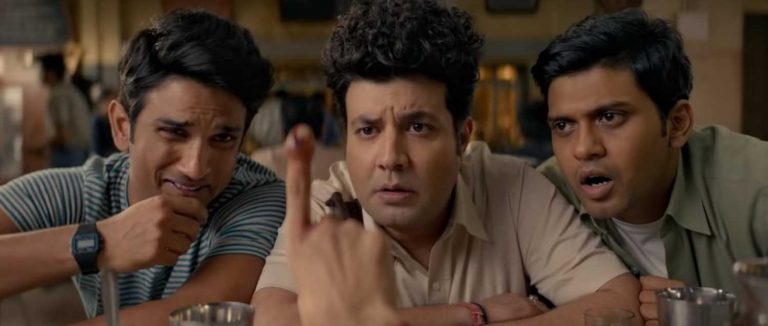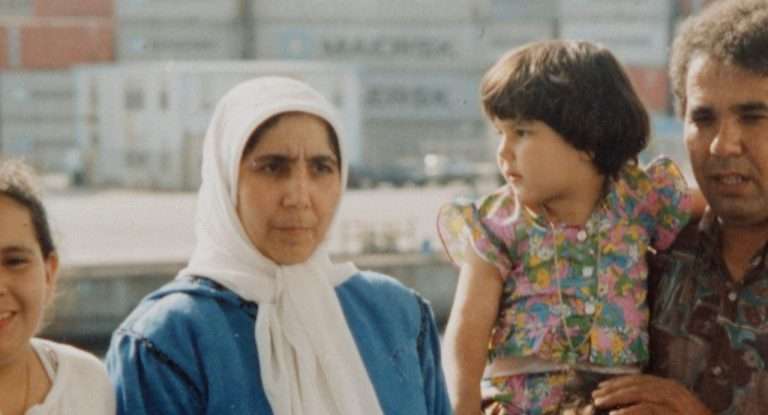In “Nadharer Bhela” (2025, The Slow Man and His Raft), Pradipta Bhattacharyya delivers a quietly audacious cinematic poem that has already made waves on the international festival circuit. Shot in just 13 days in his native village, Tehatta, Nadia, this three-hour meditation on time, difference, and belonging has been recognized at major platforms: most notably, it screened in the Harbour section at the International Film Festival Rotterdam (IFFR). On home soil, it has earned the distinction of being the only Indian entry in the Innovation in Moving Images category at the 31st Kolkata International Film Festival (KIFF), competing with fourteen other international films for the Golden Royal Bengal Tiger award.
The very fact of its selection underlines how daring and original this film is, how Bhattacharyya has not simply made another regional drama, but a deeply rooted allegory about slow existence in a world that celebrates speed. By weaving together the rustic textures of rural Bengal, myth-echoes of Behula’s raft, and the haunting spectacle of a travelling circus, he invites us to reconsider what constitutes value, productivity, and dignity. This particular festival recognition signals Nadhar’s gentle rebellion and his resistance through stillness that resonates beyond regional boundaries, touching a universal chord about human fragility, social spectacle, and the beauty of being profoundly out of sync.
Pradipta Bhattacharyya sculpts a cinematic fable that moves like a slow river, gathering quiet power as it winds through memory, myth, and social critique. Nadhar’s glacial pace has become a profound philosophical stance that questions how we assess worth in a world perpetually racing forward. His slowness, rather than being pathologised, is treated with dignity and depth, inviting a meditation on existence itself. Bhattacharyya stages a radical resistance to the time-obsessed logic of modern life, embodying a tempo that defies efficiency, not out of weakness but out of a different way of being.
The initial sequences where Nadhar is worshipped by his mother and the villagers reveal a complicated psychosocial dynamic that is not pure maternal devotion, but a ritual of faith intertwined with material calculation. His mother, far from simply loving him for his slowness, seems to sustain a system of tribute: people bring gifts to her son, because in his “divinity” they see a channel through which they can gain something tangible. In this way, Nadhar becomes a god made by humans: an icon, not through supernatural powers, but through the villagers’ own investment in him. This is a deeply unsettling contrast, where the reverence shown to him by the villagers is about what his mother can extract from their faith.
The villagers are not worshipping a transcendent being but a socially constructed figure whose sanctity brings them material returns. This mirrors how, in many religious traditions, people confer divine status on individuals they believe can influence their fortunes. Hence, Nadhar’s “worship” becomes transactional, offering him tribute in the hope that his mother, or Nadhar himself, will reciprocate, sustaining both their economy and her status in the village. But Nadhar himself remains painfully ordinary.
He is not a spiritual sage or a miracle worker; he is just slow. That dissonance is where Bhattacharyya’s critique lies: a “god” is made, promoted, consumed, and exploited, and yet the being beneath that pedestal is painfully human, limited, vulnerable.” This deification projects onto him a narrative that belongs not to Nadhar alone, but to the social fantasies of the villagers. His worship resembles how folk traditions build myths around marginal characters. And yet Bhattacharyya refuses to let the myth escape its human origins.
Nadhar’s “worship” in the film resonates with the Manasa–Behula folklore in a way that reveals how divinity is made, not born. In the Manasamangal Kāvya, Manasa’s divinity is built through conflict, sacrifice, and negotiation. She kills Chand’s sons, he refuses to acknowledge her, and finally, through Behula’s unwavering devotion, he concedes. Behula, sailing on a raft with her husband Lakhindar’s dead body, pleads with the gods and Manasa herself. Ultimately, her faith and courage win his resurrection, but only when Chand agrees to worship Manasa, albeit with his left hand, symbolically a compromise.
But Nadhar himself is not a supernatural being. Beneath the veneer of worship, he is painfully vulnerable, limited by his own “normalcy” (if slowness is what society considers “not normal”). As in the Manasa myth, what appears as divine reverence is also a mirror for human desire, fear, and the ugly mechanics of power. This worship stands as a structure of exploitation, identity, and belief. Having evoked the myth, he interrogates how gods are made and how the act of making them can both elevate and imprison.

Also Read: 10 Best Bengali Movies of the Last Decade (2010s)
The circus in the film functions less like scenery and more like a social diagram that maps how power, profit, and spectacle conspire to deform human feeling. Every laugh, shout, and thrown object is a data point in an economy that trades pain for entertainment, and the world inside the tent mirrors wider social hierarchies where bodies, differences, and vulnerabilities are priced and presented. The manager is a cardboard tyrant whose pragmatism and personal compromises make him frighteningly believable. He negotiates cruelty the same way a merchant tallies revenue, and that ordinary, bureaucratic attitude toward harm is what makes exploitation feel systemic rather than merely malicious.
The set pieces of acrobatics, folk-song interludes, and staged eroticism are choreographed not to celebrate culture but to distract and normalise the extraction of value from those who have the least cultural capital. The circus aesthetic masks an industrial logic in which spectacle lubricates dispossession. When the film stages Nadhar’s humiliating trial, the timed scramble toward Shyama while a crowd’s appetite is stoked, it’s not just a single scene of brutality but a condensed lesson in how communal pleasure can be manufactured from another’s suffering; the spectators’ participation, the pelting of vegetables, the jeer-as-ritual, reveal how violence is socialised and how anonymity in a crowd diffuses personal responsibility.
The camera’s treatment of this sequence is crucial: close-ups of the crowd’s faces trading joy for cruelty, the degrading choreography imposed on Nadhar, the way the ringmaster’s orders make cruelty procedural — all of it undermines the notion that the circus is a place of spontaneous mirth, showing instead a machinery that disciplines bodies into consumable curiosities.
The difference is commodified twice over: first by marking certain bodies as spectacle, then by converting that spectacle into a product sold to an audience hungry for domination disguised as entertainment. Beyond the economic reading, there is a psychic violence at work, where humiliation takes the form of an identity-formation, and there is a slow internalisation of shame that makes the cinema interested in how indignity fractures subjectivity, leaving characters like Nadhar exposed not only to external scorn but to an erosion of self.
This erosion is staged against the banalities of managerial self-justification and the crowd’s moral sedation, producing a civic indictment of how communities can become co-conspirators in cruelty. And at the intimate center of this indictment are the women whose presence and absence shape desire, safety, and salvation: the poignant, complicated lines of Shyama and Rupa ultimately illuminate how care and complicity intersect in the same space.
Shyama’s art springs from tradition and sincerity, rooted in the folk-opera world and steeped in myth, but when she enters the circus space, her art becomes almost invisible, eclipsed by the coarse logic of commodified entertainment. The mythic resonance she brings as a Behula figure, full of spiritual resilience and timeless sorrow, is drowned out by a crowd that craves spectacle rather than depth. The circus does not value the emotional truth she embodies. Instead, what sells is what pleases in the moment.
Haradhan, the circus manager, pressures her to abandon her dignified, mythic persona and instead perform a more provocative act, one that resembles Rupa’s commercial dance. In doing so, he strips away the sacred skin of her Behula to turn her into an object for amusement and exploitation. That transformation reveals a powerful critique: the world often sacrifices genuine, soulful culture at the altar of profit and voyeurism. Her mythic dignity is stripped as her worth becomes measured by how much the audience can consume.
Meanwhile, Rupa represents precisely that commodified logic. Her dance, her sexuality, and her ability to entertain without seeming to mean anything profound are all what the circus world prizes. She is the embodiment of what sells, unburdened by tradition or mystery, her performance shaped entirely by the commercial logic of immediate gratification. In this world, women like Shyama are forced to choose between the purity of tradition and the humiliating glare of commerce, and the circus machine that consumes their bodies and stories ultimately elevates Rupa while diminishing Shyama.
The cinematography in “Nadharer Bhela” is one of its strongest pillars, serving not just to capture scenes but to visually articulate the film’s meditation on slowness, authenticity, and spectacle. Bhattacharyya’s use of muted colours and wide framing in “Nadharer Bhela” is a quiet but powerfully dynamic storyteller, and the way he contrasts the village and the circus world brings out the film’s emotional and moral centre.
When the circus enters the frame, everything changes. The color palette shifts dramatically: rich reds, vivid greens, garish yellows, colours that burn brighter than they should, inviting and overwhelming at once. This is an entirely different realm, a manufactured spectacle. Here, brightness is built, not born. The tents and lights feel artificial, like a world constructed to deceive, to dazzle, to distract. The cost of that beauty is visible under the bright lights, where cruelty and commodification live in the same breath. Moreover, the visual contrast works like a moral lens. The gaudy colors of the circus are beautiful, but they also estrange you, as though the spectacle is masking something ugly.

Must Check Out: The 5 Best Bengali Movies of 2024
Through this visual contrast, Bhattacharyya asks us to reckon with what we value. Is the bright, flashy world of entertainment more ‘real’ than the quiet world of emotion and dignity? The answer is in the way he frames Nadhar, who, despite everything, remains the most authentic thing in that manufactured world. And in that same circus of colour, we see Shyama and Rupa too, the ones carrying the weight of myth and soul, the other alive in the spectacle, both caught in the promise and the peril of that glittering stage.
As the cruel spectacle unfolds, he is humiliated. Forced into a degrading test where he must reach Shyama in ten minutes while the crowd jeers and throws eggs and tomatoes if he fails, he finds his humanity exposed. He is no longer a mythic icon, but a tortured, very real man. In his gaze, though, there remains a tender love for Shyama, his longing for a simple, caring refuge, his innocent awe at her presence. There is a moment of reckoning, a reversal so powerful that he reclaims not his dignity, which was lost with his resonant behaviour of a sloth, and the stature of his earlier “godliness”.
In confronting Haradhan, the circus manager who has exploited him and demeaned him, Nadhar becomes a forerunner of justice. His slow body, once mocked, carries the weight of a moral uprising when he kills Haradhan. In that act, he returns to something like the godly entity he was once made out to be, but now it is tempered by his human suffering. And in this transformation, the figures of Shyama and Rupa stand as witnesses – Shyama, with her mythic soul, and Rupa, flickering in the spectacle, both bound to his journey through shame, justice, and redemption.
The music by Satyaki Banerjee does far more than underscore the scenes. It becomes a kind of emotional geography for Nadhar, mapping his inner world in tones that breathe with him. Banerjee, who plays the dotara and the sarod, draws on a training lineage that spans studying classical sarod under Pandit Tejendra Narayan Majumdar and learning dotara in the midst of folk musicians at mela-akhra gatherings, and brings both folk and classical sensibilities to the score.
This combination mirrors Nadhar’s own blended reality, rooted in tradition but estranged from the fast-paced world. Through this sound, repeated motifs linger, gently echoing Nadhar’s slow, deliberate movements, as if the music itself were floating on his raft of solitude. The dotara, with its resonant, plucked strings, feels like a whisper from a rustic soul, while the sarod, with its long, deliberate slides, brings a melancholic pull that matches Nadhar’s unhurried tempo.
This music functions as a deeply reflective extension of the film’s inner life, merging his dual mastery of folk and classical idioms to resonate with Nadhar’s emotional terrain in a philosophical and profoundly intimate way. His background as a historian by training lends his musical voice a thoughtful, academic poise, allowing him to sculpt sound that is not superficial but richly textured. The imagined lyrical themes of drifting (“bhela”), grief (“Moronaa Maa”), and existential emptiness (“Keu Naayi Kichu Naai”) align seamlessly with Banerjee’s compositions.
He uses gentle plucks on the dotara and slow, deliberate slides on the sarod to let motifs linger in space, creating a musical flow that feels like a raft of solitude carrying Nadhar through moments of longing, sorrow, and quiet despair. His work with Borno Anonyo, a band that values “mystical and urban folk”, shows his commitment to music that is not just performative but deeply spiritual and socially grounded. Moreover, his involvement in Buno 2.0, a project celebrating the “innate music” of rural artists, reflects his belief in rooted, lived traditions. That same belief resonates in the film’s score as his melodies frame Nadhar’s loneliness and his subtle resistance to a world dominated by speed.
This resistance is powerfully mirrored in cinematic terms. In a society where productivity is idolised, Nadhar’s deliberate movements foreground the sacrificial cost of speed, revealing how haste often corrodes empathy and humanity. The Wire’s review perfectly captures this: Bhattacharyya’s film is “a counterpoint to velocity and inertia”.



![Arrival [2016] : A Stunning Achievement](https://79468c92.delivery.rocketcdn.me/wp-content/uploads/2016/11/maxresdefault-1-768x512.jpg)
![The Policeman’s Lineage [2022] Review: Crime Eat Crime in a Dog Eat Dog World](https://79468c92.delivery.rocketcdn.me/wp-content/uploads/2022/06/The-Policemans-Lineage-Movie-Review-1-768x512.jpeg)
![The New Girlfriend [2015]: A pyschosexual exploration of Friendship!](https://79468c92.delivery.rocketcdn.me/wp-content/uploads/2016/02/1436307724-The_New_Girlfriend_tickets-768x432.jpg)
![Doctor Strange In The Multiverse of Madness [2022] Review: One Of The Most Stylistically Distinct MCU Outings In A While](https://79468c92.delivery.rocketcdn.me/wp-content/uploads/2022/05/Doctor-Strange-In-The-Multiverse-of-Madness-Benedit-Cumberbatch-768x322.jpg)

